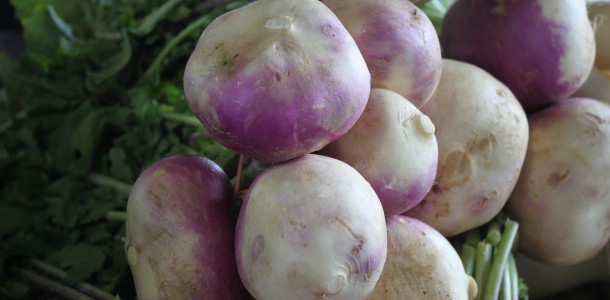I have to admit that last year when the Food Network invited bloggers like me to share our tips, tricks and recipes for turnips I had to really think about it. Having never made turnips before I thought that a root vegetable would do well roasted. Our family thought that my favorite balsamic vinaigrette and fresh thyme from my garden would be the perfect complement to this root vegetable. The end result was okay and many of you told me that you enjoyed the recipe. I must admit that it was not a family favorite and I have not made a turnip recipe since last year.
Isn’t that sad?
When I saw that turnips had made another appearance on this year’s Fall Fest list of vegetables I knew that I had to get to the “root” of my problem.
I decided to call in the big guns. If anyone knew about tackling turnips it would be the local farmers and their families that I admire and appreciate so much.
Off I went talking to local farmer after local farmer, their mamas, their sisters and those they thought made the best turnips in the south. Of course I called my good cooking buddy and friend Secretary of State Elaine Marshall. Secretary Marshall grew up on a farm owned by parents and she learned a lot about growing her own food. She gave me valuable advice as well.
Local farmers are the unsung heroes of our great country. They work hard day and night. If not for their hard work, diligence and passion for what they do, our families would not enjoy the fresh fruits, or in this case veggies, of their labor. The advice from these amazing southern folks gave us the information we need to tackle turnips.
Here’s what they all shared:
How to Choose and Cook Turnips
- Freshly dug turnips should not be bitter; old makes for bitterness
- turnips are best dug up after the first frost – here in the south we’re a little behind some of you
- the smaller root the better — the end result is a sweeter turnip
- turnips longer in the ground makes for mealy and pithy turnips
- Northerners eat rutabagas which are a type of turnip
- a teaspoon of granulated sugar will take any unwanted bitterness out of cooked turnips
- the smaller turnips are delicious and local turnips, when dug fresh out of the ground, should be sweet and never need sugar
- turnips should peel pretty easy if freshly dug
- one farmer told me that he peels turnips twice if they were in the ground too long or a bit older than he would like
- If you are preparing to freeze your turnips you want the freshest turnips right out of the ground
- Dig at peak and freeze
- To freeze: boil and mash chunky with a potato masher or ricer or slice and roast with oil, salt and pepper (just like a cut up sweet potato)
- smaller turnips have better flavor; larger are often fed to livestock
- turnips greens are delicious
- wash turnip greens in hot water several times and remove from the stem
- most Southerners cut their turnips into cubes or slice and boil them
- many use a hand held ricer or potato masher to mash up their turnips – they prefer a hearty consistency not creamy
- once the turnips are boiled taste them; if they are bitter add a teaspoon of granulated sugar before mashing
After several calls it happened. Tony Lee of Lee Farms and Sons told me that his sister learned from his mama and makes “the best turnips in the south.” That’s what I wanted to hear!
Tony told me he would have Ms. Dunn call me right away. I love living in the south…ten mintues later this is what I learned from Ms. Dunn:
Patricia happily shared with me what she learned from her mama:
Place a pork shoulder roast in a Dutch oven. Cover with water. Bring to a boil and cook for two to three hours on simmer until tender.
Patricia removes the pork shoulder and uses it in pulled pork sandwiches. The delicious stock is used to cook her turnips and turnip greens in.
Patricia washes her greens in very hot water several times. She removes the greens from their stem and places them in the stock. The greens cook until they are tender and this depends on how tough they are. Keep checking. Once tender remove with a strainer and set aside. The greens can be served chopped as a turnip salad 9sort of like collard greens) or with the turnips once they are cooked.
Place your cubed or sliced turnips in the stock and allow them to cook until tender. Patricia said this takes less time then the turnip greens.
Remove with a strainer and use a potato masher or ricer to mash your turnips up a bit. In the south the consistency of their turnip mash is a bit chunky — not creamy like mashed potatoes. A little freshly ground black pepper and you too can cook like a farmer’s wife, mom or in this sister! Thanks, Patrica!
Tip: If you slice your turnips you do not have to mash them.
I think a little crispy bacon on top would be lovely don’t you?
I found just that – turnips fried in bacon by Amy Glaze – my new obsession!
For more amazing turnip favorites be sure to check out what my friends have created:
Feed Me Phoebe: Mashed Turnips with Miso Butter
The Lemon Bowl: Baked Turnip Chips
Purple Cook: Turnip and Tomato Curry, Recipe Reviewed
Domesticate Me: Roasted Root Vegetable Salad with Herbed Goat Cheese
Napa Farmhouse 1885: Easy Roasted Root Vegetables
Red or Green: Roasted Turnip and Parsnip Soup with Toasted Walnuts
Dishing: Roasted Turnips with Parmesan
Taste With The Eyes: Quinoa Corn Timbale, Turnip Confit, Quail Egg and Fried Sage with a Demi-Glace
The Sensitive Epicure: Mashed Turnips with Celery Root
Devour: 4 Ways to Cook Turnips
In Jennie’s Kitchen: Turnip Soup
FN Dish: Turnip Recipes Revisited




 Hello, I’m Elise Johnson and I’m so glad you found your way here! From my own experience, cooking and eating together as a family nurtures and strengthens family relationships quicker and stronger than any other way. Join me as I continue my grandmother’s legacy of
inter-generational cooking by inspiring families and friends to make memories in the kitchen.
Hello, I’m Elise Johnson and I’m so glad you found your way here! From my own experience, cooking and eating together as a family nurtures and strengthens family relationships quicker and stronger than any other way. Join me as I continue my grandmother’s legacy of
inter-generational cooking by inspiring families and friends to make memories in the kitchen. 